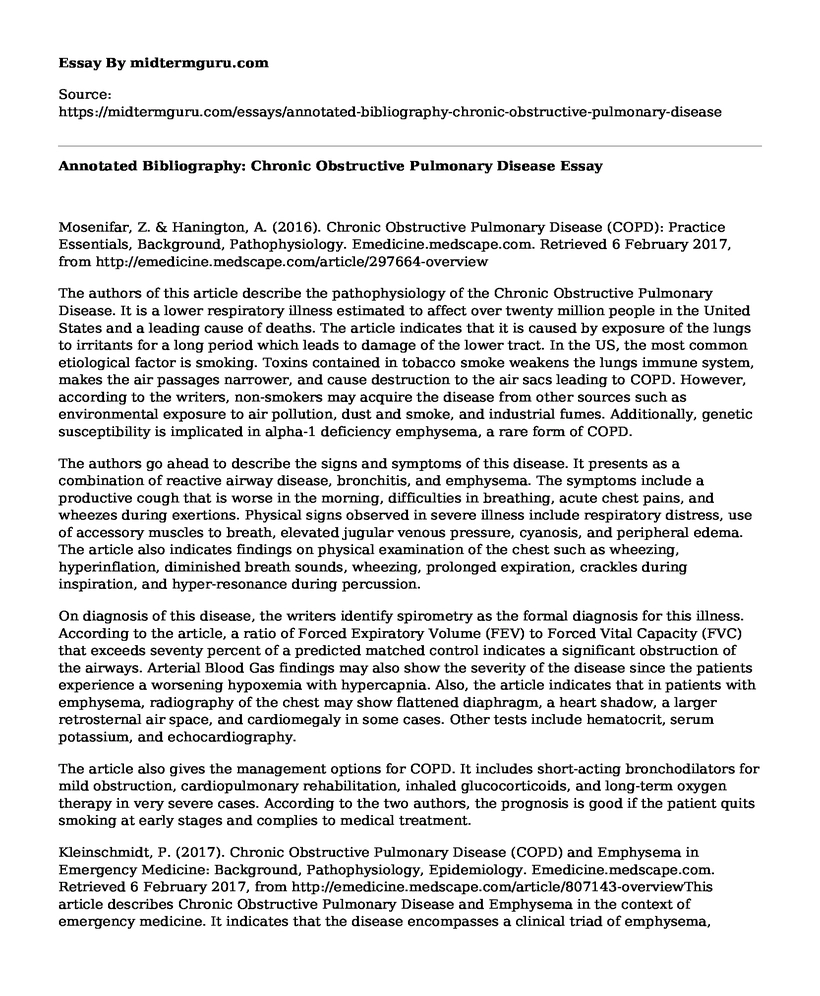Mosenifar, Z. & Hanington, A. (2016). Chronic Obstructive Pulmonary Disease (COPD): Practice Essentials, Background, Pathophysiology. Emedicine.medscape.com. Retrieved 6 February 2017, from http://emedicine.medscape.com/article/297664-overview
The authors of this article describe the pathophysiology of the Chronic Obstructive Pulmonary Disease. It is a lower respiratory illness estimated to affect over twenty million people in the United States and a leading cause of deaths. The article indicates that it is caused by exposure of the lungs to irritants for a long period which leads to damage of the lower tract. In the US, the most common etiological factor is smoking. Toxins contained in tobacco smoke weakens the lungs immune system, makes the air passages narrower, and cause destruction to the air sacs leading to COPD. However, according to the writers, non-smokers may acquire the disease from other sources such as environmental exposure to air pollution, dust and smoke, and industrial fumes. Additionally, genetic susceptibility is implicated in alpha-1 deficiency emphysema, a rare form of COPD.
The authors go ahead to describe the signs and symptoms of this disease. It presents as a combination of reactive airway disease, bronchitis, and emphysema. The symptoms include a productive cough that is worse in the morning, difficulties in breathing, acute chest pains, and wheezes during exertions. Physical signs observed in severe illness include respiratory distress, use of accessory muscles to breath, elevated jugular venous pressure, cyanosis, and peripheral edema. The article also indicates findings on physical examination of the chest such as wheezing, hyperinflation, diminished breath sounds, wheezing, prolonged expiration, crackles during inspiration, and hyper-resonance during percussion.
On diagnosis of this disease, the writers identify spirometry as the formal diagnosis for this illness. According to the article, a ratio of Forced Expiratory Volume (FEV) to Forced Vital Capacity (FVC) that exceeds seventy percent of a predicted matched control indicates a significant obstruction of the airways. Arterial Blood Gas findings may also show the severity of the disease since the patients experience a worsening hypoxemia with hypercapnia. Also, the article indicates that in patients with emphysema, radiography of the chest may show flattened diaphragm, a heart shadow, a larger retrosternal air space, and cardiomegaly in some cases. Other tests include hematocrit, serum potassium, and echocardiography.
The article also gives the management options for COPD. It includes short-acting bronchodilators for mild obstruction, cardiopulmonary rehabilitation, inhaled glucocorticoids, and long-term oxygen therapy in very severe cases. According to the two authors, the prognosis is good if the patient quits smoking at early stages and complies to medical treatment.
Kleinschmidt, P. (2017). Chronic Obstructive Pulmonary Disease (COPD) and Emphysema in Emergency Medicine: Background, Pathophysiology, Epidemiology. Emedicine.medscape.com. Retrieved 6 February 2017, from http://emedicine.medscape.com/article/807143-overviewThis article describes Chronic Obstructive Pulmonary Disease and Emphysema in the context of emergency medicine. It indicates that the disease encompasses a clinical triad of emphysema, chronic bronchitis, and asthma. The disease is caused by infiltration of the lower respiratory airways with inflammatory immune cells such as the CD-4 and CD-8 T-cells, and B-cells. The inflammatory response leads to repair and remodeling of the tissues which may cause obstruction. The writer notes that tobacco smoking, a major etiological factor, limits the ability of the airways to control the immune process. Other factors known for causing the illness include bronchiectasis, cystic fibrosis, air pollution, occupational exposure, and deficiency of alpha-1 antitrypsin protein.
Signs and symptoms of the disease mentioned include dyspnea and intolerance to physical exercise presenting as bronchitis, emphysema, or asthma. According to the author, chronic bronchitis presents with a productive cough, progressive cardiac failure with edema, and recurrent respiratory infections. For emphysema, the author writes that patients may have a history of difficulties in breathing, a non-productive cough at a later onset, and cachexia. Asthmatic patients may produce wheezes and a dry cough in addition to dyspnea.
In the diagnosis of this disease, Arterial Blood Gas is critical to determine the severity and acuteness of the illness. Other laboratory tests include a complete blood count, serum sodium, and BNP levels. The writer notes that imaging studies such as chest radiography and electrocardiography may also be used to establish the extent of illness. Pulmonary function tests such as the ratio of Forced Expiratory Volume to Forced Vital Capacity have also been noted down as important tests for diagnosis.
The management of this condition, according to this author, should focus on bronchodilators. For instance, patients may be given short-acting beta agonists nebulizers or short-acting anticholinergics such as ipratropium. In some cases, Continuous Positive Airway Pressure (CPAP may also be used in some severe cases. The author indicates that emergency care for COPD includes magnesium, bronchodilators, Heliox, antibiotics, and CPAP or Biphasic Positive Airway Pressure (BPAP).
Cite this page
Annotated Bibliography: Chronic Obstructive Pulmonary Disease. (2021, May 31). Retrieved from https://midtermguru.com/essays/annotated-bibliography-chronic-obstructive-pulmonary-disease
If you are the original author of this essay and no longer wish to have it published on the midtermguru.com website, please click below to request its removal:
- Research Paper on External Iliac Artery Endofibrosis
- Essay Sample on Ethical Issues on the Use of Artificial Organs on Humans
- The Nursing Issue to be Presented - Research Paper
- Definition Essay on Vaccination
- Diarrhea Outbreak in Philippines Towns: Report From International Society of Infectious Diseases - Essay Sample
- Sciatic Nerve: Causes & Symptoms of Sciatica Pain - Essay Sample
- Affordable Healthcare: Todd and Reginald Case Study







